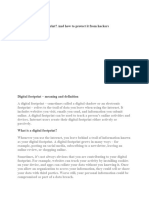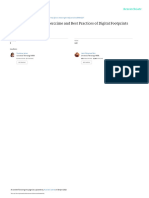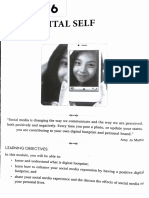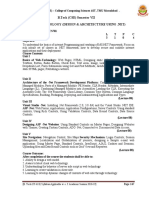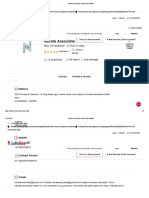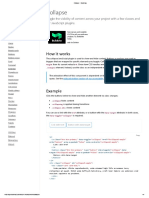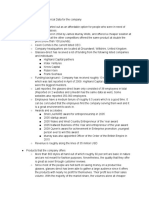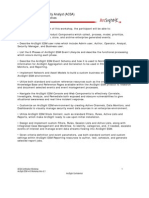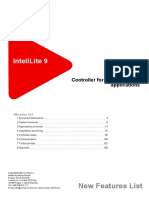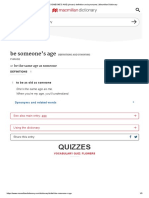ICT LESSON 2 -LECTURE
"Scenarios Where Digital Citizenship is Crucial"
A. Social Media Interactions
B. Online Gaming
C. Email Communication
D. Online Learning Platforms
E. Content Creation and Sharing
Digital citizenship - refers to the responsible use of technology by anyone who uses
computers, the Internet, and digital devices to engage with society on any level. It
encompasses a wide range of behaviors and skills that are necessary for effective and
ethical participation in digital environments.
According to Ribble (2017), there are nine elements of Digital Citizenship. These elements
include:
1. Digital Access
2. Digital Commerce
3. Digital Communication
4. Digital Literacy
5. Digital Etiquette
�6. Digital Law
7. Digital Rights and Responsibilities
8. Digital Health and Wellness
9. Digital Security (Self-protection)
" Importance of Digital Etiquette and Security"
1. Digital Etiquette - Emphasize the importance of treating others with respect online,
just as one would in person.
2. Digital Security - Highlight the need to protect personal information and the
potential risks of sharing too much online.
“DIGITAL FOOTPRINTS AND IDENTITY”
What is a Digital Footprint?
A digital footprint is the trail of data that individuals leave behind when they use
the internet. This includes all the information that is shared, both intentionally and
unintentionally, through various online activities such as social media interactions,
website visits, emails, and online shopping. Digital footprints can be categorized into two
types:
1. Active Digital Footprints - These are the data trails you leave intentionally, such as
posts on social media, blog entries, or any other content you actively upload or share
online.
2. Passive Digital Footprints - These are the data trails you leave unintentionally, such as
cookies that track your browsing habits, IP addresses, and other metadata collected by
websites and online services.
�"Importance of Digital Footprints"
● Privacy and Security - The data you leave behind can be used to build a profile about
you, which can be exploited for malicious purposes such as identity theft or targeted
cyber-attacks (Solove, 2007).
● Reputation Management - Your digital footprint can affect your reputation.
Employers, colleges, and other entities often search for online information about
candidates, and inappropriate content can have negative consequences (Berkelaar, 2014).
● Personalization - Companies use digital footprints to personalize user experiences,
such as recommending products or content based on browsing history (Turow, 2011).
“Managing Your Digital Footprint”
Managing your digital footprint involves being mindful of the information you share
online and taking steps to protect your privacy.
● Privacy Settings - Regularly review and adjust the privacy settings on your social
media accounts and other online services to control who can see your information.
● Search Yourself - Periodically search for your own name on search engines to see
what information is publicly accessible.
● Think Before You Post - Consider the long-term impact of the content you share
online. Once something is posted, it can be difficult to remove it completely.
● Use Secure Connections - Ensure that you are using secure (HTTPS) connections
when browsing the internet to protect your data from being intercepted.
Digital Identity
Digital identity refers to the online persona that is created through your digital
footprints. It encompasses all the information available about you online, including social
media profiles, online transactions, and any other digital interactions.
Components of Digital Identity
● Personal Information - This includes your name, date of birth, address, and other
identifying details.
�● Professional Information - This includes your employment history, professional skills,
and educational background, often found on platforms like LinkedIn.
● Social Information - This includes your social media activity, such as posts, likes,
comments, and the networks you are part of.
● Behavioral Information - This includes your browsing habits, purchase history, and
other online behaviors that can be tracked and analyzed.
“Risks Associated with Digital Identity”
● Identity Theft - Cybercriminals can use your personal information to steal your
identity and commit fraud (Newman & McNally, 2005).
● Reputation Damage - Negative information or inappropriate content associated with
your digital identity can harm your personal and professional reputation.
● Data Exploitation - Companies can exploit your digital identity for targeted
advertising and other commercial purposes without your explicit consent (Acquisti &
Gross, 2006).
“Protecting Your Digital Identity”
● Strong Passwords - Use strong, unique passwords for different online accounts and
change them regularly.
● Two-Factor Authentication - Enable two-factor authentication (2FA) for an added
layer of security.
● Be Skeptical of Phishing - Be cautious of emails, messages, or websites that ask for
personal information.
● Regular Monitoring - Keep an eye on your online accounts for any suspicious activity
Digital Identity
Digital identity refers to the online persona that is created through your digital
footprints. It encompasses all the information available about you online, including social
media profiles, online transactions, and any other digital interactions.
Components of Digital Identity
● Personal Information - This includes your name, date of birth, address, and other
identifying details.
�● Professional Information - This includes your employment history, professional skills,
and educational background, often found on platforms like LinkedIn.
● Social Information - This includes your social media activity, such as posts, likes,
comments, and the networks you are part of.
● Behavioral Information - This includes your browsing habits, purchase history, and
other online behaviors that can be tracked and analyzed.
“Risks Associated with Digital Identity”
● Identity Theft - Cybercriminals can use your personal information to steal your
identity and commit fraud (Newman & McNally, 2005).
● Reputation Damage - Negative information or inappropriate content associated with
your digital identity can harm your personal and professional reputation.
● Data Exploitation - Companies can exploit your digital identity for targeted
advertising and other commercial purposes without your explicit consent (Acquisti &
Gross, 2006).
“Protecting Your Digital Identity”
● Strong Passwords - Use strong, unique passwords for different online accounts and
change them regularly.
● Two-Factor Authentication - Enable two-factor authentication (2FA) for an added
layer of security.
● Be Skeptical of Phishing - Be cautious of emails, messages, or websites that ask for
personal information.
● Regular Monitoring - Keep an eye on your online accounts for any suspicious activity
































